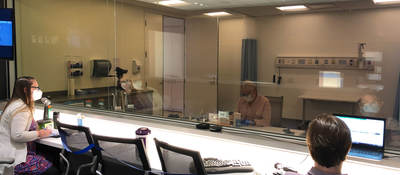December 2, 2020
In my more than seven years working for a consumer medical device company, my most memorable and exciting research studies were those that involved spending time with users in their own homes. Observing procedures in hospital environments offers insights into workflows and tools, but entering a user’s home is enriching on another level; by inviting you into their homes, people share an intimate portrait of their lives, enabling you to learn about the tasks they perform, but also about their lifestyles, values, routines, and struggles. As a guest in someone’s home, you have the opportunity to connect with that person in a way that is generally not possible when conducting research in a more public or professional setting; when it comes to understanding users’ needs, this learning opportunity can be invaluable.
Benefits and challenges of in-home user research
In-home research has benefits and challenges. Notable benefits include:
- Accessing users who are immobile or who might have difficulty traveling to a research facility due to physical limitations or cost/time constraints
- Reducing the likelihood of last-minute cancellations or no-shows by making participation more convenient
- Helping the participant feel more comfortable through familiar surroundings and the presence of other household members
- Providing a multi-faceted picture of the user’s life, use context, and product experiences
Common challenges include:
- Longer research days/weeks, due to local travel time, traffic, and parking
- Recruiting and scheduling complexities based on needing to identify willing, qualified, and available participants within a small geographic area
- Less predictability and control over research conditions, requiring research teams to be adaptable and create contingency plans
Guidelines for effectively conducting in-home research
Should you decide that conducting research in users’ homes makes sense for your study, consider the recommendations below to help you plan and conduct successful in-home sessions.
Maximize schedule efficiency. In-home studies are inherently inefficient, but you can save travel time and costs by scheduling participants based on geographic proximity; this requires coordination and might mean you need to identify a greater number of qualified candidates to enable selection based on availability and location. While efficiency is important, remember to schedule breaks for lunch or coffee throughout the day to give the research team an opportunity to regroup, debrief, and attend to biological needs. Also, have participant contact information handy in case you experience unexpected delays or get lost on the way to your destination.
Be prepared. In addition to participant feedback, you will want to document your surroundings. Bring recording equipment (e.g., cameras, microphones, tripods), as well as tools to measure lighting, sound levels, and temperature (as relevant to your product). Anticipate what might go wrong: if you travel with physical prototypes, bring supplies for repairs (e.g., glue, tape, spare parts), in case a prototype is damaged in transit or during participant handling. Bring extra memory cards and back-up batteries, noting that charging devices and transferring files can be more difficult when on the move. And print extra hard copies of forms – ask additional household members to sign a non-disclosure if they will be within earshot of the conversation. Finally, carry proof of your credentials: without a formal research facility to lend legitimacy to your study, providing proof of your identity and employer can help reassure participants that you are who you say you are.
Recognize the intimacy of the situation. While being on their “own turf” might put some participants at ease, hosting strangers in their homes will likely make other participants feel uncomfortable. As such, it is important to be respectful and to try to ease any discomfort. The tone you set with your language, demeanor, and appearance not only impacts participants’ comfort, it can also influence participants’ willingness to openly and honestly share details about their lives. For example, wearing a suit might seem intimidating in the context of a home environment while wearing a t-shirt might seem unprofessional, thereby diminishing trust with the participant. Related to speaking, try to be friendly and conversational, using words that are familiar to most lay people to avoid alienating participants. Also note that facial expressions, while perhaps difficult to control, can help to build or break rapport; you will encounter pets, disorder, dirt, unfamiliar sounds and smells, and disruptions of all sorts, but keep an open mind and be accepting of differences, and avoid making a participant feel judged.
Set expectations. Another way to put participants at ease is to be transparent about what you are doing and why. Well before your visit, contact the participant for a personal introduction and to explain the research, including planned activities, materials, objectives, areas of the home the team would like to see, and how many people will attend the session. Also, consider providing the same information in writing, so participants can review it before their scheduled sessions. Allow ample time for participants to consider participation before requiring a commitment, and encourage them to freely ask any questions they or their family members have regarding the research.
Prioritize safety. Always conduct in-home research in teams and never enter a participant’s home alone. Have a cell phone easily accessible at all times, and provide a colleague back in the office a copy of the schedule with participant names and addresses so team whereabouts are trackable. If you feel like something is wrong while inside someone’s home, trust your instincts and end the session. While you want to be open and respectful of a participant’s views and lifestyle, signs of aggression, violence, instability, or hate should be taken very seriously. A colleague once shared a story with me about having all of the research team’s camera equipment stolen when thieves greeted them at the door of their scheduled home visit. Rare situations like this might not be foreseeable, but caution and awareness can be key factors in avoiding potential danger.
Despite some risks and challenges, in-home research can be quite rewarding. Careful planning and preparation can facilitate your study running smoothly and yielding valuable insights about your users and aspects of their lives that can significantly influence their interactions with, and ultimate satisfaction with, the product you develop.
Kathryn Mizuchi is Senior User Researcher at Emergo by UL's Human Factors Research & Design division.
Learn more about HFE and usability testing for medical devices:
- HFE user research support for medical devices, IVDs, and combination products
- Medical device and product evaluation
- Webinar: Human factors engineering for medical devices
- Webinar: Safe in-person usability testing during COVID-19
Request more information from our specialist
Thanks for your interest in our products and services. Let's collect some information so we can connect you with the right person.







